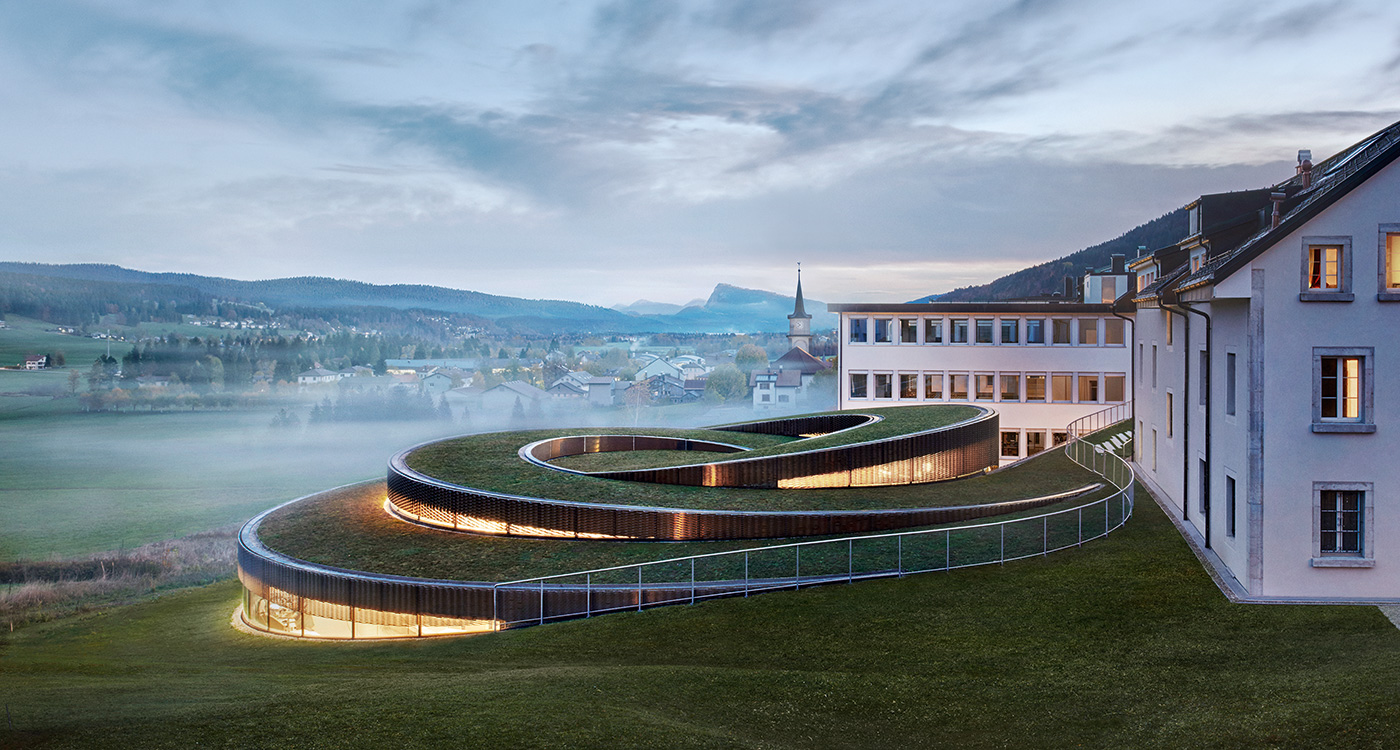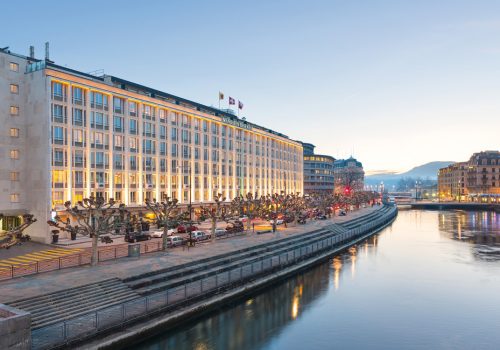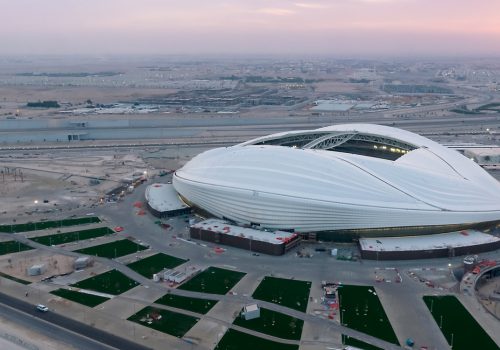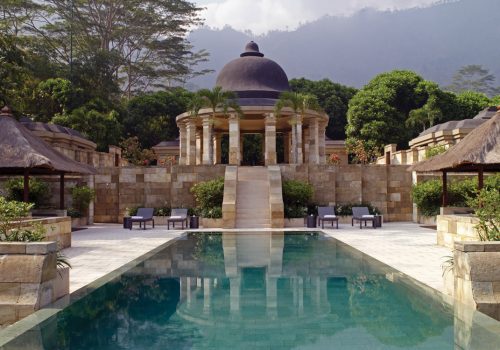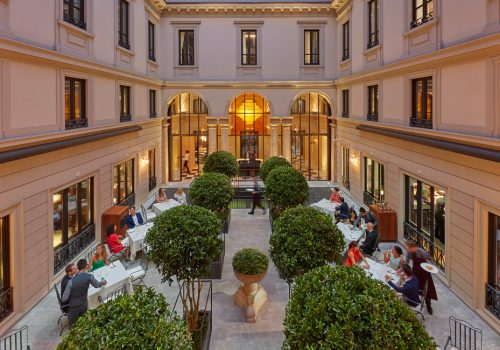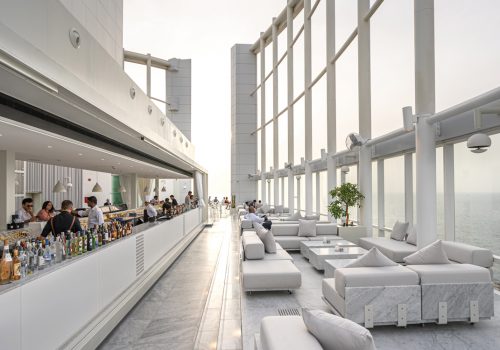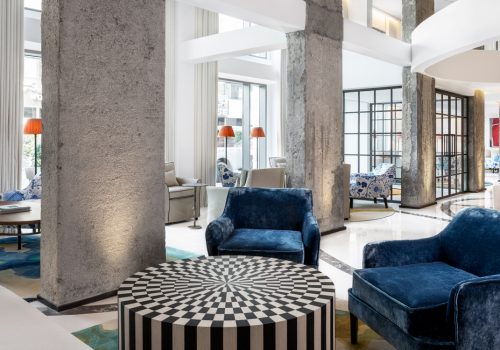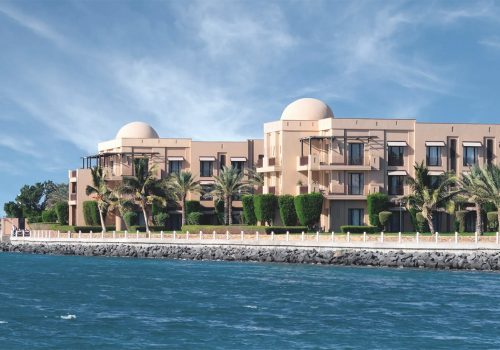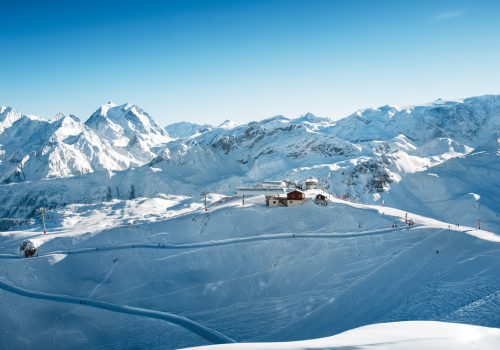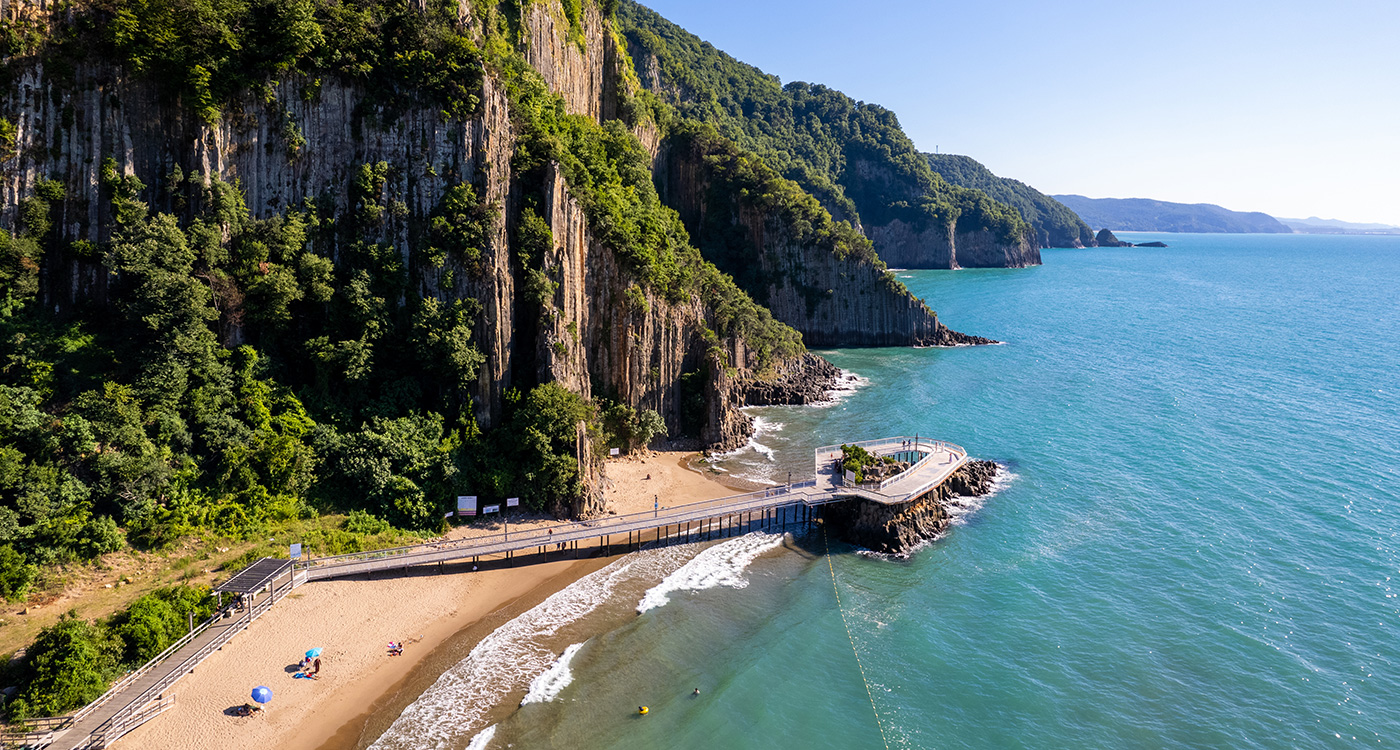HOW DID THE IDEA OF CREATING THE MUSÉE ATELIER AUDEMARS PIGUET COME ABOUT?
[SÉBASTIAN VIVAS, AP’S HERITAGE AND MUSEUM DIRECTOR] The goal of showcasing Audemars Piguet historical timepieces in our village of Le Brassus is not something new, as we’ve been doing it for a few decades. The museum is not just a means of sharing our rich history with visitors but also a medium for us to remain in touch with our past in order to build our future. That is why, in 1992, we opened our first museum within a section of our Founder’s House – the place where Audemars Piguet debuted in 1875. Step by step, the museum expanded and by 2004 it ended up occupying the entire house. And, as the company has grown, evolved and transformed, so too have our ambitions for the museum, eventually we took the decision to create a purpose-built landmark that would not just house watches but display a museography that expresses the free- and forward-thinking spirit of the brand.
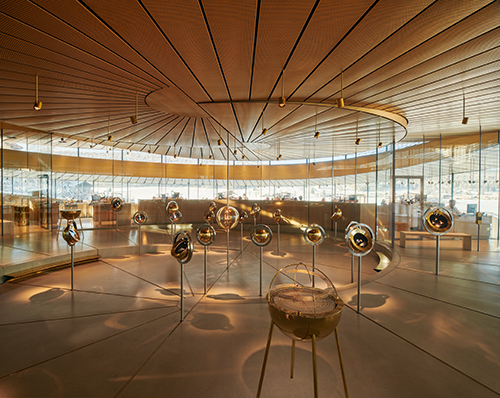
ABOVE: The museum’s interior features ramped floors that connect uneven levels.
So, in 2013 the company hosted an architecture competition for the design of a new building that could complement the original house. I, myself, had the privilege of writing the architecture brief, and it seemed an almost impossible task to realise: create a building that was extraordinary, futuristic, and particularly respectful of both the surrounding landscape as well as the Audemars Piguet Founders’ House, with which it would have to interact smoothly and perfectly. How could a building be both visible and invisible at the same time?
But magic happened, and it was love at first sight. That is how the jury felt when they laid their eyes upon BIG’s (Bjarke Ingels Group) proposal: a spiral emerging from the ground, a sculpture as much as a building, resting entirely on curved glass, perfectly making the link between the inside and the outside, past and future, technicality and aesthetics. No one had ever built such a building at an altitude of 1,000 metres in a valley famous for its endless winters but BIG won the architecture competition in 2014.
WHAT DO YOU MEAN BY THE MUSEOGRAPHY NEEDING TO EXPRESS THE FREE- AND FORWARD-THINKING SPIRIT OF THE BRAND?
Since the beginning of the project, our dream has been to offer each visitor willing to cross oceans and mountains to come to Le Brassus an unforgettable experience. That is why we decided to offer the best of who we are to each visitor, regardless of their interest. We aimed to express the most important facets of our brand – its history, craftsmanship, passion for mechanics and design, its free spirit and of course, its people – in the most exciting and interesting way. And, as the watch collection is so magnificent, it needed a location that would match both its quality and aesthetic. Taking all that into account, we hope that everyone, whatever their age, wherever they come from, whether they’re the most experienced watch collectors or amateurs of architecture and tourists discovering our beautiful region, finds something that will move them here. We hope that they say “wow” a few times and experience something surprising and memorable.
PROGRAMMATICALLY SPEAKING, HOW HAS THE MUSEUM’S EXPERIENCE BEEN DESIGNED?
The project began with a simple question: what do we want to tell our visitors? This is why we gathered stories based on historical studies, our collections, experiences from the previous museum, discussions with watchmakers and clients, we collected testimonies from “living memories”, and so on. And then we organised all those stories like chapters in a book. Based on that, we searched for a museographer who would be capable of translating these narrations into a tri-dimensional experience and that was German company Atelier Brückner. They managed all the scenography, staging and showcasing of the timepieces, lighting and creation of the site visit. As a matter of fact, they imagined the museum’s scenography as a musical score and, as a result, the visit alternates between crescendos, highpoints and contemplative moments to offer visitors as rich an experience as possible.
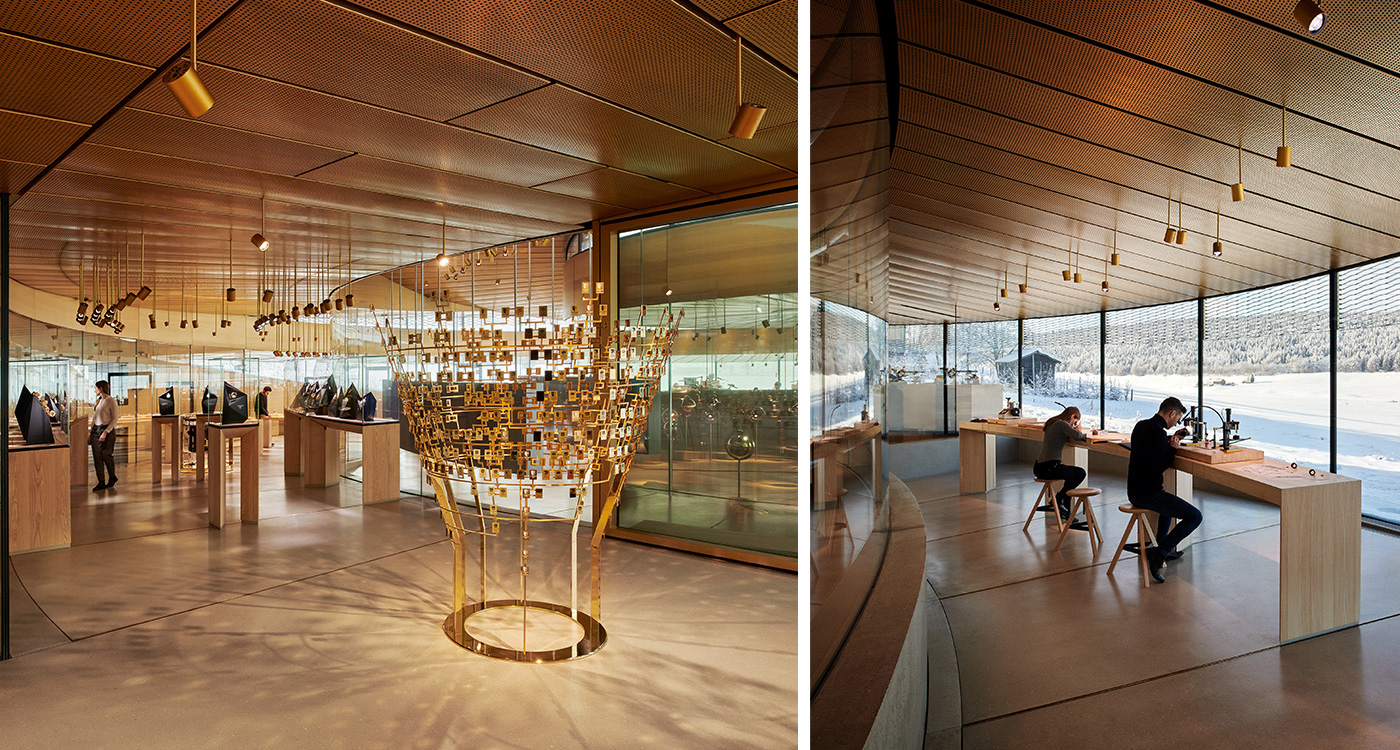
ABOVE: The building serves multiple purposes: as an extensive archive, a museum and a workshop where visitors can witness the watchmaking process from behind glass walls.
IN MORE CONCRETE TERMS, WHAT ARE THE VARIOUS CHAPTERS?
The narrative path passes from the origins of watchmaking in the Vallée de Joux to our Royal Oak, Royal Oak Offshore, Royal Oak Concept, Code 11.59 by Audemars Piguet collections, among others. The exhibition culminates at the centre of the spiral, with a large exhibition of AP’s calendar, chiming and chronograph watches orbiting around the Universelle (1899), the most complicated watch ever produced by Audemars Piguet.
These interludes take the shape of sculptures, automata, kinetic installations, mock-ups of intricate mechanical movements and didactic tables to give rhythm and life to some key aspects of the exhibition. Although the Grandes Complications and Métiers d’Art Ateliers are not visited by the grand public, they play an important role in the scenography as visitors can see our craftspeople at work.
WE FOUND THAT TO BE AN INTERESTING MOVE, SO THE MUSEUM REALLY IS ALSO A FUNCTIONING ATELIER?
Yes, the Grandes Complications and Métiers d’Art [high jewellery gem-setters] Ateliers were moved into the Musée Atelier, so the museum is the permanent workplace for those watchmakers. They work at the heart of the spiral, surrounded by glass walls, which allows them to see out and others to see in and observe them at work. Why is that important? I would call it living culture, something echoed in the museum’s name: Musée Atelier, with its focus and showcasing of the craftspeople and talents working at Audemars Piguet.
THE MUSEUM SHOWCASES 300 TIMEPIECES. HOW LONG HAS IT TAKEN TO ACCUMULATE THE MUSEUM’S COLLECTION?
Audemars Piguet started to gather a collection at the end of the 1980s, just after the quartz crisis that almost brought the Swiss watchmaking industry to its knees. The company understood how important it was to remember one’s origin and evolution when it comes to building the future and, over these 40 years, we have continuously enriched the collection with both recent and antique watches. We collect the timepieces that we consider to be the most iconic in terms of design, history and technicity. The 300 watches exhibited in the Musée Atelier are the most meaningful ones, chosen from a much larger collection that’s presented through itinerant exhibitions around the world.
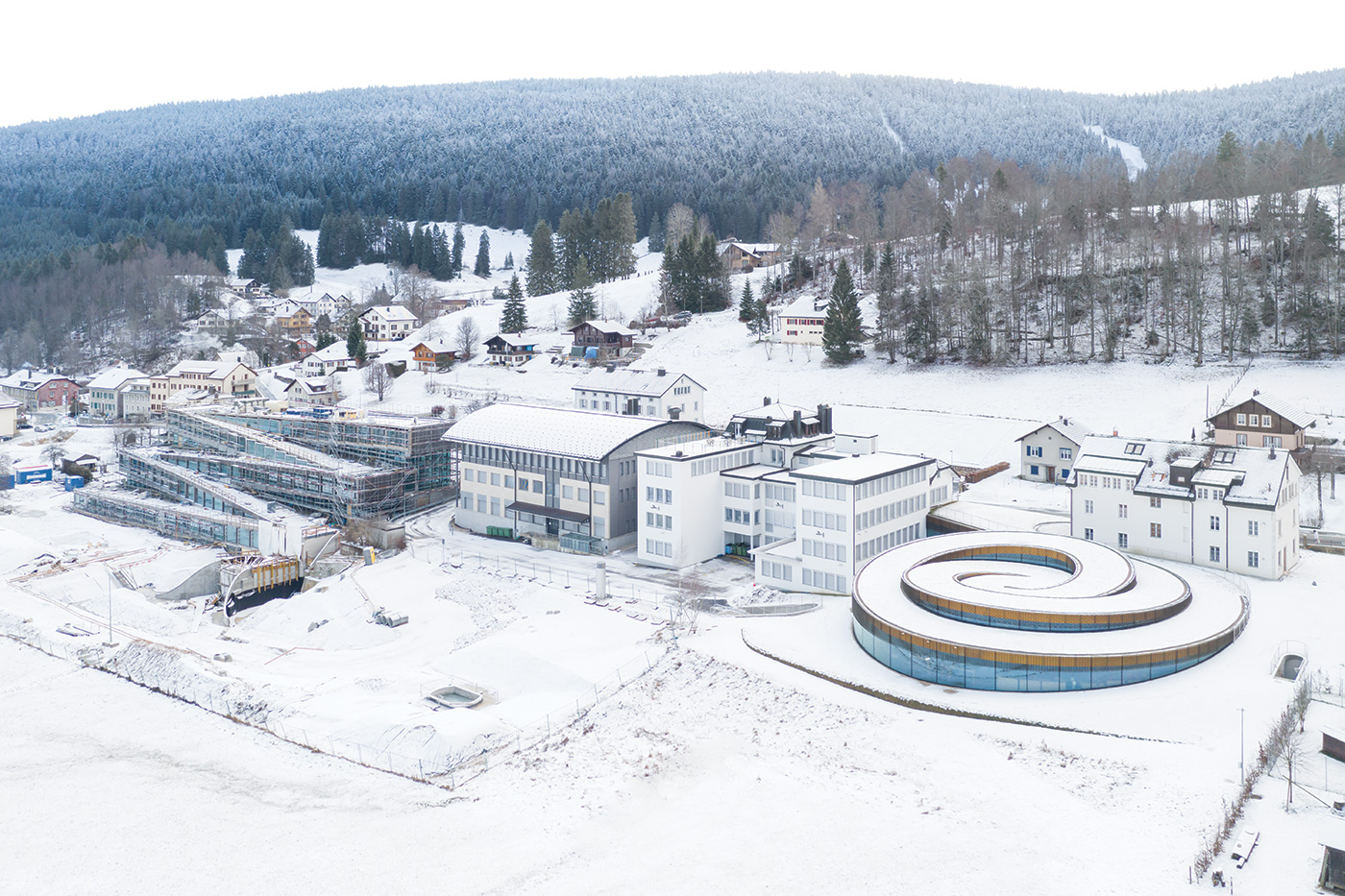
ABOVE: To the left of the museum you can make out a construction site. That is the Hôtel des Horlogers. Like the museum, the hotel will feature a roof that slopes down to the ground (via a stack of linear tilted slabs) in order to integrate the architecture with the sloping topography of the site.
AND WHY DID YOU CHOOSE TO INCLUDE WATCHES THAT ARE NOT MADE BY AUDEMARS PIGUET?
Audemars Piguet has a rich history and it wanted to pay tribute to all the people who made that history possible, and who supported its development. There is a notion that is important for Audemars Piguet – it is introduced in the first part of the tour – called “établissage”. Historically, Switzerland has developed a unique network and structure in which suppliers and companies delivered movements and external parts to assemblers, called “établisseurs”, who then put together and sold the final product. Notions of union, collaboration, co-creation resonates with Audemars Piguet. It is important to recognise other people’s work because without them Audemars Piguet would not exist.
TELL US A LITTLE ABOUT THE COMPLEXITY OF THE RESTORATION OF THOSE IMPORTANT RARE WATCHES?
First a bit of context, especially for those who have not yet had the opportunity to visit the new museum. The Restoration Atelier is located on the top floor of the Founder’s House where, as explained earlier, Jules Louis Audemars and Edward Auguste Piguet established the business in 1875. It is there that a handful of highly specialised watchmakers perpetuate the rare ancestral expertise required to restore antique timepieces in pristine condition. It is crucial for Audemars Piguet to preserve this unique heritage, and we are very proud of it. The biggest challenge for them is to master the know-how developed for more than 150 years. They have to be able to master but also perpetuate them to the next generations. Among the most important work done, I would mention the Universelle pocket watch (1899). The Universelle contains more than 20 complications and 1,168 components for its movement. A real masterpiece of complication! It took four years for our best watchmakers to restore the timepiece, before it could be exhibited at the very centre of the Musée Atelier Audemars Piguet.
DOES AP STILL POSSESS THE ORIGINAL SCHEMATICS OF ALL THE WATCHES IT EVER MADE IN THOSE DAYS?
This is an excellent question. Today, every new model is created thanks to the work of watchmakers and engineers. Every component is drawn, quantified, updated, and so on. During the company’s first 75 years, the reality was quite different. There were no drawings, no plans and few pictures of the watches. In fact, every timepiece was unique and the know-how was entirely based on the craftsmen experience and knowledge. Each worked according to what they had learned in school or during their career.
The first plans appeared during the 1950s and 1960s. As the quantity produced remained extremely low, some plans were not complete. The long transition accelerated in the 1980s and 1990s, with the modernization of the watch conception and fabrication. The role of the Heritage Department is to preserve the memory of the company. Thus, our restoration watchmakers transmit the pre-modernisation know-how, tools and old furniture, while our archivists are preserving historical plans and other important company documents.
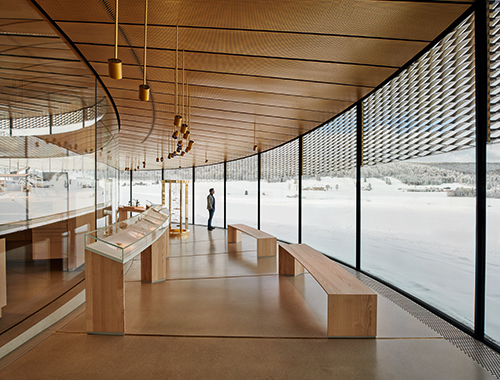 YOU MENTIONED EARLIER “RESPECTING THE PAST AND BUILDING THE FUTURE” BUT WHAT DOES THAT MEAN?
YOU MENTIONED EARLIER “RESPECTING THE PAST AND BUILDING THE FUTURE” BUT WHAT DOES THAT MEAN?
In our Musée Atelier, some watches are over 250 years old and they still tell time. The mechanical watch is probably the last highly complex object produced to work for several centuries. But it doesn’t just tell time, it also builds a bridge between the past and the future; a mechanical watch transmits the passion of the craftspeople who created it. As an emotional object, it reflects the identity of its owner who then passes it on to the next generation. This is what guides us today. We are the oldest ‘manufacture’ still owned by its founding families. Thanks to this independence, we are free to trace our own path, and we have chosen to do so with a long-term vision. We perpetuate and pass on traditional craftsmanship to future next generations, while constantly reinventing ourselves and making uncompromising choices. Our aim is not only to create timepieces, but to foster the numerous talents in the company because our strength is our people.
GOING BACK TO THE MUSEUM’S UNTRADITIONAL DESIGN, HOW DID YOU MANAGE TO GET PLANNING PERMISSION FOR IT?
Audemars Piguet is the oldest fine watchmaking manufacturer still in the hands of its founding families (Audemars and Piguet). It was established in Le Brassus in 1875 and it still remains here to this day. We are particularly attached to this remote valley of the Swiss Jura Mountains. Therefore, it was essential that the project appeals to everyone including the people living in Le Brassus. So, before we began began the project, we discussed it in detail with as many parties as possible, including tourist offices, neighbours, local inhabitants, etcetera, so that everybody knew what was coming. Furthermore, we invited the Mayor of Le Brassus to be a member of the architectural jury. But, as you mention, the final winning design was not compliant with the local rules of construction, even if it was incredibly attractive! So it was really thanks to the fact that everyone was so convinced by the project – including the political decision-makers – that the impossible became possible.
AND WHAT ASPECT OR INNOVATION IN THE MUSEUM ARE YOU MOST PROUD OF?
What I love in the museum is its richness, its elegance, its variety, its emotional dimension. What I am the most proud of, is the fact that, since its opening on June 25th last year, not only AP employee have adopted the museum, but all the hundreds of people who participated in its creation are proud of it and want to show it to their families and friends.
FINALLY, AP IS NOW CONSTRUCTING A NEW HÔTEL DES HORLOGERS, WHICH RESEMBLES AN ENTANGLEMENT OF RAMPS, A FEW HUNDRED METRES FROM THE MUSEUM. CAN YOU TELL US A LITTLE BIT MORE ABOUT THAT?
The hotel actually existed before. Since at least 1853 in fact, so it is the oldest hotel in Le Brassus (with a different name).
The Hôtel des Horlogers will offer to visitors, tourists and VIPs a unique and immersive experience of the Vallée de Joux and will especially highlight Le Brassus’s beauty environment.
The new design of the Hôtel des Horlogers is also signed by BIG and was imagined as an integral part of the Vallée de Joux environment. This is the reason why we chose BIG. For a certain continuity to the Musée Atelier project but also for its creativity and ingenuity in creating a perfect balance between the building and the environment. The first stone was laid in Le Brassus on June 4th, 2018. The construction is ongoing. As for the opening, it is planned for the beginning of 2022. I can also share with you that the hotel will offer 50 rooms with four-star comfort and views over the Risoud forest, one restaurant and a lounge bar, a wellness area, a fitness facility as well as seminar rooms.


